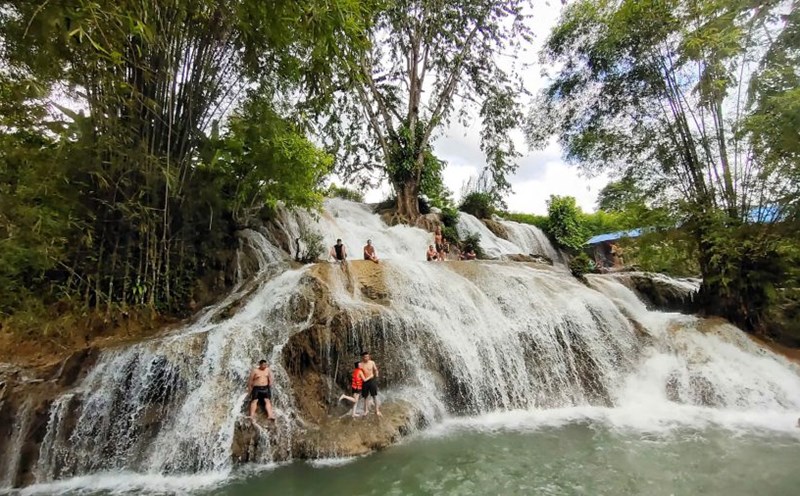In Taquile, an island in Peru, the men are not just fishermen or farmers - they are also people who weave dreams with wool and convey love through each spear. And there, sincere feelings can be measured by... a hat that knows how to hold water.
An island in the sky
Titicaca Lake is the largest lake in South America, located in the Andes Mountains between the borders of Bolivia and Peru. The western part of the lake is located in Puno city - Southeast Peru. For the indigenous people, Titicaca is a sacred, mysterious plateau lake, where the ancient Incas believed that their ancestors were born from water. From the hillside, you can see the entire vast, mirror-like lake, in the distance the high Andes peaks on the horizon and the white clouds.
From the lake shore, to get to Taquile Island in the middle of the lake, it is necessary to travel about 30km by boat. The water surface is so flat that the gentle cloud clusters above also clearly block the lake surface. At 3,810m, Titicaca Lake is only about 1,000m lower than the highest Mont Blanc peak in Western Europe. Anyone who comes to Taquile on brilliant sunny days feels like they are standing in the sky.
The island has about 2,000 residents - most of whom still maintain a traditional lifestyle. Men wear black sweaters and colorful belt covers. Women wear colorful long dresses that can be worn by men up to 8 layers, looking like mobile pyramids. Everyone wears a hat - not just to cover themselves from the sun, but to express their identity.
In Taquile, the hat is a miniature resume: Color, shape and how to weave the hat reveals where the person comes from, whether they are married or not, what job they do. The hats were not bought from the market or supermarket - all of which were made by them.
One of the unique cultural features of Taquile Island is the famous tradition of weaving and knitting wool. The weaving and knitting profession here has been recognized by UNESCO as an intangible cultural heritage since 2008.
Women wea on the neck weaving frame, spinning the fur from alpaca on the grass field along the lake. Men often sit on stone walls to weave. The special thing is that they weave hats, and weaving learning begins early from the age of 6 - 7. The boys were given needles by their fathers and started their vocational training journey with simple hats, combined with two tones, gradually moving towards more complex models with many colors and sophisticated motifs.
By the age of 18, every guy must know how to weave a chullo hat - a long hat with a fringe, not only to wear a scarf, but also to be... a love created by love. When a guy falls in love with someone, he will work hard to knit a beautiful and private bottle, then give it to the girl as a confession. If the girl agrees, the hat will become a symbol of a marriage commitment.
The hat is an act of proposal
A proposal on Taquile Island is not like roses or knees, but a hat that can... keep water.
When the young couple wants to go further, a meeting between the two families will be held. Everyone dressed well, carrying gifts, coca leaves and wine. And then in that bustling atmosphere, the chullo would be brought out for... inspection.
The girl's father would hold the hat, roll it, check the regularity of the fibers and the tightness of the knot. The tighter the hand, the more straight the hat is without being soft, the more it is appreciated. Finally, the most important test: The hat will be filled with water. The father went around among the guests, the hat was raised. The longer the hat held the water, the more he was appreciated for his patience and sincerity.
If everything goes well, the girl will step forward and give her lover the belt she weaves. On top are symbols of their dreams: A house, a flock of sheep, the number of children they desire... mixed with the Year of the Snake are even her hair. She tied her belt around the guy's waist - and their relationship was officially recognized.
Here, any man has to learn to weave a hat. That is how they prove their ability, said an islander.
Although tourism has today penetrated island life, the Taquile community still retains its identity. Weaving and weaving art is still the soul of life - the thing that connects, nourishes, and protects ancient traditions from the Inca period. People still learn weaving from a young age, still assign each other to do manual work, and decide everything together.
Today, Taquile Island also has a private craft training school, helping to pass on weaving and weaving techniques to the younger generation. The agricultural calendar beltworks with seasonal patterns, the chullo hats with both classic and modern motifs - all of which have been preserved and innovated over time.
However, tourism development also brings pressure: scarcity of raw materials, higher production demand, and the increasing import of goods from the mainland. But despite that, Taquile is still a place where every belly of the needle is sent with affection, every hat is a love story, and every hand is a life book of the community.
On Taquile Island, love does not need beauty. A well-woven hat, strong wool threads to keep water, a belt with a girl's hair mark - all enough to make a simple but profound proposal.
In the noisy modern world, where everything can be "buy quickly" or " click quickly", the story of Taquile Island reminds us that: sincere feelings still require time and effort - and sometimes, just a hat that knows how to hold water is enough.









